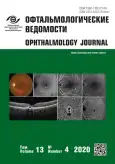湿性老年性黄斑病变抗血管生成治疗效果的预测
- 作者: Kharakozov A.S.1, Kulikov A.N.1, Maltsev D.S.2
-
隶属关系:
- S.M.Kirov Military medical academy
- S.M. Kirov Military Medical Academy
- 期: 卷 13, 编号 4 (2020)
- 页面: 7-13
- 栏目: Original study articles
- URL: https://journals.rcsi.science/ov/article/view/46198
- DOI: https://doi.org/10.17816/OV46198
- ID: 46198
如何引用文章
详细
目的:揭示湿性老年性黄斑病变(AMD)患者玻璃体内注射阿伯西普治疗效果的预后因素。
材料和方法:该研究中纳入了36例(45只眼,26名女性和10名男性,平均年龄在74.4±10.9岁)先前治疗失败的湿性AMD患者。所有患者均接受了每月3次阿伯西普玻璃体注射以及之后再次注射4次(每次间隔为2个月)。评估了人口学特征、初始最佳矫正视力(BCVA)、中心视网膜厚度(CMT)和光学相干断层扫描(OCT)的结构变化,以判断在10个月的随访中与BCVA的相关性。
结果:在观察期结束时,初始视力从31.0±15.0(~0.32)个字符增加到37.0±14.0(~0.4)个字符(p=0.003)。治疗开始时和随访结束时的CMT分别为357±110和269±70μm(p<0.001)。最终BCVA与初始视力(r=0.62;p<0.0001)、初始CMT(r=-0.48;p=0.001)以及从症状出现到开始治疗的时长(r=-0.32;p=0.03)在统计学上有显著相关性。OCT图像上黄斑结构的变化与最终BCVA无关,除了椭圆体带状态(p<0.001)。男性的最终BCVA在统计学上明显低于女性(分别为34.7±14.0(~0.4)和45.0±9.2(~0.63)个字符,p=0.03)。
结论:初始视力、性别、CMT、从发病到开始治疗的时长和椭圆体带状态是湿性AMD患者抗血管生成治疗效果的预测因素。
作者简介
Alexandr Kharakozov
S.M.Kirov Military medical academy
编辑信件的主要联系方式.
Email: kharakozoff@mail.ru
ORCID iD: 0000-0003-4598-0826
SPIN 代码: 1208-5237
Graduated. S.M. Kirov Military Medical Academy
俄罗斯联邦, 194044, St. Petersburg, st. Academician Lebedev, 6Alexey Kulikov
S.M.Kirov Military medical academy
Email: alexey.kulikov@mail.ru
ORCID iD: 0000-0002-5274-6993
MD, PhD, DSc, Assistant Professor, Head of the Ophthalmology Department. S.M. Kirov Military Medical Academy
俄罗斯联邦, 194044, St. Petersburg, st. Academician Lebedev, 6Dmitrii Maltsev
S.M. Kirov Military Medical Academy
Email: glaz.med@yandex.ru
ORCID iD: 0000-0001-6598-3982
MD, PhD, Head of Medical Retina Division of Ophthalmology Department. S.M. Kirov Military Medical Academy
俄罗斯联邦, 194044, St. Petersburg, st. Academician Lebedev, 6参考
- Benyelles N, Soubrane G. [Age-related macular degeneration. (In French)]. Rev Prat. 2006;56(11):1194-1201.
- Friedman DS, O’Colmain BJ, Muñoz B, et al. Eye Diseases Prevalence Research Group. Prevalence of age-related macular degeneration in the United States. Arch Ophthalmol. 2004;122(4): 564-572. https://doi.org/10.1001/archopht.122.4.564
- Либман Е.С., Толмачев Р.А., Шахова Е.В. Эпидемиологическая характеристика инвалидности вследствие основных форм макулопатий: материалы II Всероссийского семинара «Макула-2006». – Ростов на/Д, 2006. – С. 15–22. [Libman ES, Tolmachev RA, Shahova EV. Epidemiologicheskaya kharakteristika invalidnosti osnovnykh form makulopatiy: materialy II Vserossiiskogo seminara “Makula-2006”. Rostov-on-Don; 2006. P. 15-22. (In Russ.)]
- Wong WL. Global prevalence of age-related macular degeneration and disease burden projection for 2020 and 2040: a systematic review and meta-analysis. Lancet Glob Health. 2014;2(2):106-116. https://doi.org/10.1016/S2214-109X(13)70145-1
- Boyer DS, Antoszyk AN, Awh CC, et al. Subgroup analysis of the MARINA study of ranibizumab in neovascular age-related macular degeneration. Ophthalmology. 2007;114(2):246-252. https://doi.org/10.1016/j.ophtha.2006.10.045
- Lim JH, Wickremasinghe SS, Xie J, et al. Delay to treatment and visual outcomes in patients treated with antivascular endothelial growth factor for age-related macular degeneration. Am J Ophthalmol. 2012;153(4):678-686. https://doi.org/10.1016/j.ajo.2011.09.013
- Ying GS, Huang J, Maguire MG, et al. Baseline predictors for one-year visual outcomes with ranibizumab or bevacizumab for neovascular age-related macular degeneration. Ophthalmology. 2013;120(1): 122-129. https://doi.org/10.1016/j.ophtha.2012.07.042
- Mitamura Y, Mitamura-Aizawa S, Katome T, et al. Photoreceptor impairment and restoration on optical coherence tomographic image. J Ophthalmol. 2013; 2013:518170. https://doi.org/10.1155/2013/518170
- Oishi A, Tsujikawa A, Yamashiro K, et al. One-year result of aflibercept treatment on age-related macular degeneration and predictive factors for visual outcome. Am J Ophthalmol. 2015;159(5):853-860. https://doi.org/10.1016/j.ajo.2015.01.018
- Coscas F, Coscas G, Lupidi M, et al. Restoration of outer retinal layers after aflibercept therapy in exudative AMD: Prognostic value. Invest Ophthalmol Vis Sci. 2015;56(6):4129-4134. https://doi.org/10.1167/iovs.15-16735
- Kwon YH, Lee DK, Kim HE, et al. Predictive findings of visual outcome in spectral domain optical coherence tomography after ranibizumab treatment in age-related macular degeneration. Korean J Ophthalmol. 2014;28(5):386-392. https://doi.org/10.3341/kjo.2014.28.5.386
- Ferrara D, Silver RE, Louzada RN, et al. Optical coherence tomography features preceding the onset of advanced age-related macular degeneration. Invest Ophthalmol Vis Sci. 2017;58(9):3519-3529. https://doi.org/10.1167/iovs.17-21696
- Lee H, Ji B, Chung H, et al. Correlation between optical coherence tomographic hyperreflective foci and visual outcomes after anti-VEGF treatment in neovascular age-related macular degeneration and polypoidal choroidal vasculopathy. Retina. 2016;36(3):465-475. https://doi.org/10.1097/iae.0000000000000645
- Wickremasinghe SS, Sandhu SS, Busija L, et al. Predictors of AMD treatment response. Ophthalmology. 2012;119(11): 2413-2414. https://doi.org/10.1016/j.ophtha.2012.06.056
- Будзинская М.В., Фурсова А.Ж., Педанова Е.К. Специфические биомаркеры ответа на антиангиогенную терапию // Вестник офтальмологии. - 2020. - Т. 136. - № 2. - С. 117-124. [Budzinskaya MV, Fursova AZh, Pedanova EK. Specific biomarkers of response to antiangiogenic therapy. Russian annals of ophthalmology. 2020;136(2):117-124. (In Russ.)] https://doi.org/10.17116/oftalma2020136021117
- Zhang X, Lai TY. Baseline predictors of visual acuity outcome in patients with wet age-related macular degeneration. Biomed Res Int. 2018;2018:9640131. https://doi.org/10.1155/2018/9640131
- Leung K, Downes S, Chong V. A retrospective analysis of the effect of subretinal hyper-reflective material and other morphological features of neovascular age-related macular degeneration on visual acuity outcomes in eyes treated with intravitreal aflibercept over one year. Vision (Basel). 2018;2(1):5. https://doi.org/10.3390/vision2010005
补充文件










